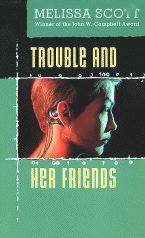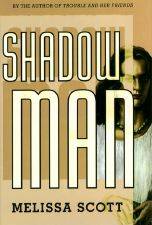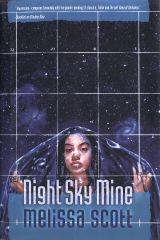

| Melissa Scott has her own home page. | ||
| Click on a book's image or title to order from Amazon.com |

Trouble and Her Friends
Tor Books, © 1994, 379 pp, ISBN #0-812-52213-3Reviewed September 1996
There's something that I should admit up-front here: I have a basic prejudice against SF which deals with "the net", cyberspace, virtual reality, hacking-n'-cracking, and the like. I don't entirely know why, but I think a lot of it is that my technical background with the stuff has led me to form opinions about computer networks which are very different from the popular fictional representations of their future. I also think that I simply don't see virtual environments as dramatic enough to make good fiction.
One example of what I mean is the concept of anonymity as it exists in Trouble and her Friends: A person's icon can exist at location X, while the actual person is at location Y, and it is very hard to find the actual person even if you know where the icon is. This doesn't make much sense to me, since any good sysop with access to the computer should be able to figure out where the person is by examining the packets of computer data carrying what the icon 'sees' to the person's brain. Those packets need to have some method of knowing where to go to get to the human, and it should be possible to snag some of those packets and see where they're going. This may be difficult or expensive in terms of processing power, but an entity such as the federal government in Trouble should certainly be able to accomplish this.
(Conversely, I found it strange that the feds could find Trouble easily when NewTrouble started committing his hijinks, but were unable to find NewTrouble or even to determine that he and Trouble were not the same person. Something about this seemed implausible to me.)
I also found the final on-line showdown to be very jarring; the extremely vivid descriptions of how everything on the net could be interpreted in physical human-form terms was impossible for me to swallow. The "mirror-regions" especially, which were defeated by crawling (crawling!) slowly through them seemed especially egregious, like something out of a bad fantasy/quest novel than a high-tech thriller.
But once I broke through the barrier caused by what I saw as an unlikely representation of the computer net, I found Trouble and Her Friends to be quite enjoyable, indeed.
I was actually pretty much sucked in by the first chapter, when Trouble decided to disappear, and certainly her relationship with Cerise was the driving force of the book. I've occasionally experienced myself meeting an old friend after several years - and many changes on both our parts. It's always interesting to see how we relate after it all. (In one such instance, I found that I got along much better with the friend in question than when we were kids; in another, I find that we relate in almost exactly the same way no matter how much time passes. It's pretty cool.)
I thought Cerise's reactions to Trouble's disappearance were very well portrayed - her shock and numbness, and the stress that showed through when she encountered the girls on the street on her walk to the bar. Although it seemed clear from early on that the two were still entirely compatible when they met again, three years later, I thought Scott did a good job of showing them dance around each other as they tried to figure out what was different and what was the same about each other. Some scenes - especially in the car as they hid out near the Maine beach - were achingly powerful, and delivered all the emotional impact one could ask for given the situations involved; Scott rarely shied away from the ramifications of what her characters were doing.
Although in a sense it was kind of obvious, I did enjoy the wordplay involving double meanings of the word "trouble", and a few other similar bit of semantic obfuscation (such as "What are your intentions?"). Somehow I always feel like I should be annoyed with prose dialogue which portrays the situation as some sort of ritual combat, with each participant thinking things like, "Of course, she'll say that next," or, "I'll pass on that gambit", and the like, since intellectually it seems like a terribly contrived mechanism. But actually it rarely seems forced to me and I thought Scott used it very effectively, especially between Trouble and Cerise.
On the other hand, it seemed like Scott was playing a subtle game with the descriptions in the story. In particular, it seemed like she rarely gave really concrete physical descriptions of objects or people in the real world - except for Cerise - but she went to some pains to describe what things looked like on the net. This sometimes gave the book a surreal and slightly frustrating feel - I was annoyed never to find a really good description of what Trouble looked like in real life, and sometimes found the descriptions of on-line objects distracting. Ultimately I think it was a worthy experiment (if it was a conscious thing at all), and in general Scott tended to describe real-life things in terms of their function and significance well enough that it made up for the lack of a visual image.
The story's biggest flaw, I felt, was that the motivations behind the plot were sketchy at best. Why was the Mayor acting as he was? Why didn't he rein in NewTrouble? When both of them were killed, I felt a bit cheated, that we'd never find out what their motives were. It basically left this whole facet of the book feeling unfinished; it was the element which set events in motion in the story, and we never really find out why.
It was an interesting book, with a lot of powerful scenes, but much more focused on the people and their reaction to each other - and on the personal and social politics surrounding the situation - than on the technology. A good approach, I think.

Shadow Man
Tor, © 1995, 308 pp, ISBN #0-312-86206-7Reviewed May 1997
Shadow Man is clearly an allegory for today's problems with bigotry directed at gays and lesbians (among others; women, for instance). In Scott's future world here, humanity has "split" (through the plot device of mutagenic drugs which were necessary for FTL space travel) into five different sexes: Male, female, "mem" (males with present but nonfunctional female genatalia), "fem" (females with present but nonfunctional male genetalia) and "herm" (hermaphodites). The book's interstellar society, the Concord, has come to grips (more or less) with these changes. (I did rather wonder how the Concord organizes their public rest rooms, though.)
However, the book takes place on the planet Hara, a colonized world just recently reintroduced to humanspace. Hara rejects the notion that there are five sexes (even though they have them too), and all citizens of Hara are forced into one of two legal genders (male or female).
The metaphor is not as heavy-handed as it sounds from simple description; as in her other books, Scott is adept at building a believable world and background, and dropping her characters into them as part of the integrated whole. Shadow Man focuses on Warreven, an important Haran who is a herm but is legally male, and Tatian, a male from the Concord reprsenting a company's business interests on Hara. Hara lacks metal (and therefore is somewhat medieval in its technology and even culture), but has many organic goods to export. Warreven and Tatian come into contact mainly through political maneuvering which gives them interlocking economic concerns.
But, as with Scott's later novel, Night Sky Mine, the plot never really takes off. There's a lot of political action, and a lot of in-depth exploration of what it means to be a herm on Hara (pretty tough when the lynchings start), but the flashpoint of the book - when Warreven faces Hara's Most Important Man to convince him that the "odd-bodied" should be recognized - results in the conservative forces more in control then ever, and Warreven exiled to the Concord, there to learn more about runing a revolution. And then the book ends. This leaves Shadow Man feeling like little more than a well-crafted parable.
The novel also feels rather myopic in its use of Warreven and Tatian as point-of-view figures, as it feels like there's an awful lot of the world (both Concord and Haran) that we're missing out on, pieces that are important to the overall picture. Additionally, despite some pointed sexual tension between the two protagonists early on, nothing really develops between them; since I felt it was debatable whether anything should have happened between them, I wondered if perhaps that tension should have been left out entirely.

Night Sky Mine
Tor, © 1996, 384 pp, ISBN #0-312-85875-2Reviewed January 1996
Night Sky Mine is at its best when it's exploring the complex world which Melissa Scott has created as the backdrop for her characters and story. And in stark contrast to her earlier novel, Trouble and her Friends, Night Sky Mine's plot unfolds slowly, revealing its ultimate direction only a little at a time.
Night Sky Mine's backdrop contains two major elements. The first is a projection of how computers and software might evolve several hundred years hence: Programs become so complicated that humans can no longer effectively write them by hand, so such programs are turned loose into the network to evolve on their own, forming a complex ecology in which chunks of code feed on each other, and have "floral" and "faunal" characteristics. Although an interesting backdrop, I personally could not regard this vision as anything but the purest fantasy, as I was unable to reconcile it with my own knowledge of how computers work, a rather naive anthropomorizing of software, which bears little-to-no resemblance with natural evolution.
Of more interest was the caste system in which people are organized in Night Sky Mine's future. The novel primarily focuses on the police; the workers for the company (the Night Sky Mining Corporation, or NSMCo, in this instance); the Union, who are technically-savvy sorts with computer implants allowing their minds to interact directly with the machines, and the Travellers, essentially space-nomads. Writing fiction within an invented occupational-caste system is hard (c.f. Robert Silverberg's Nightwings), but I think Scott approached it from the best angle: Rather than dealing with the whole society's problems through the device, the castes are simply a different way of highlighting the barriers which isolate humans from one another in all places and times. Certain individuals can overcome these obstacles, but on the whole it's very, very hard for us to understand one another.
The plot primarily takes place in a star system owned by NSMCo in which ships have been being attacked and abandoned at a rate of one per year over the last decade-and-a-half. Ista, a teenaged girl in training to become a sort of master programmer, was found at age two abandoned on one of the earliest targets, and she's grown up on NSMCo's main station in the system without any idea of who she really was. The police in a nearby star system finally decide to investigate covertly, and their main agents are Rangsey and Tarasov, two men who are in a rather difficult point in their relationship.
As I mentioned, the plot unfolds gradually, and ultimately is relatively straightforward. The rewarding elements of the book involve the tension between Rangsey (a disaffected Union member) and Tarasov (a former member of the Transport class, now a police techie sort), and Ista's experiences and relationships with the people around her: Her status as a "non-person" due to the lack of official identity papers, her relationship with her step-mother and her programming mentor, and her best friend Stinne, another girl on whom Ista has a crush.
Although the ride through the novel is captivating (thanks in part to Scott's invented terminology, which is only occasionally confusing, and often rather poetic), ultimately I was disappointed in the book, for hardly any of the key points of contention are resolved. Yes, we learn why the ships are disappearing, but Ista doesn't really learn her true identity (certainly not concretely enough to prove it to the authorities and make her legal), and Rangsey and Tarasov's crises never seem to come to a head or resolve themselves. Ultimately, this makes the book feel bleak and empty - particularly from a character standpoint - and I wondered a bit just what the point was, to go through all this for what in the end amounted to very little payoff.
hits since 13 August 2000.